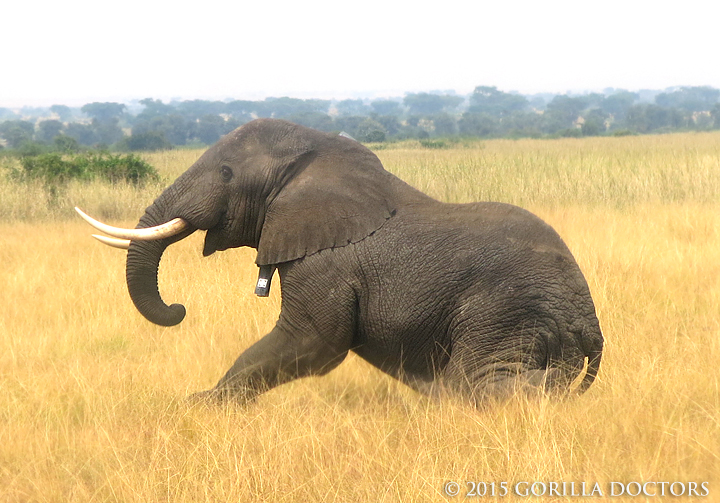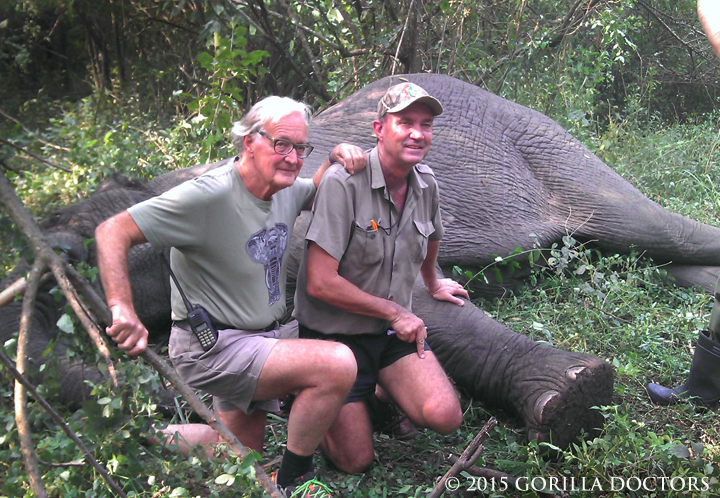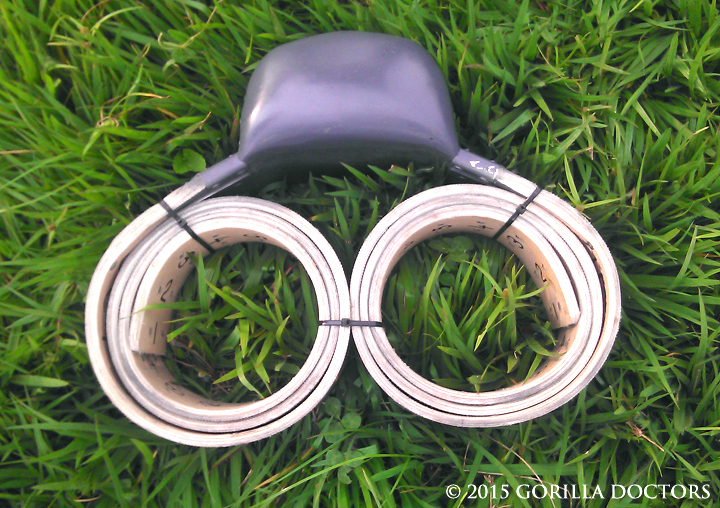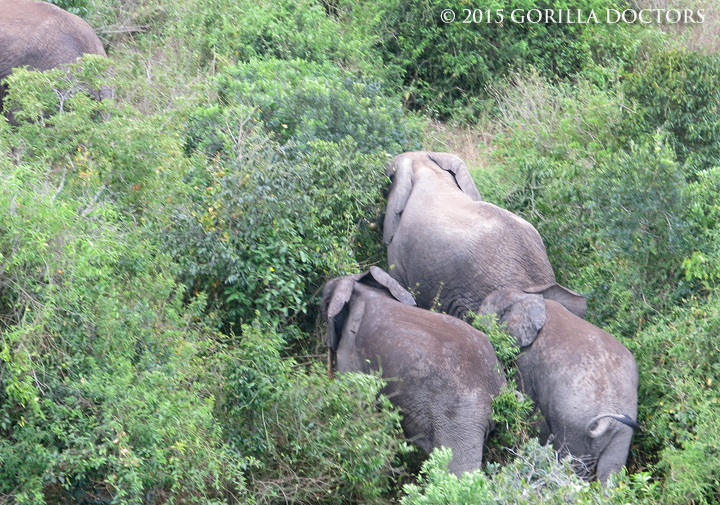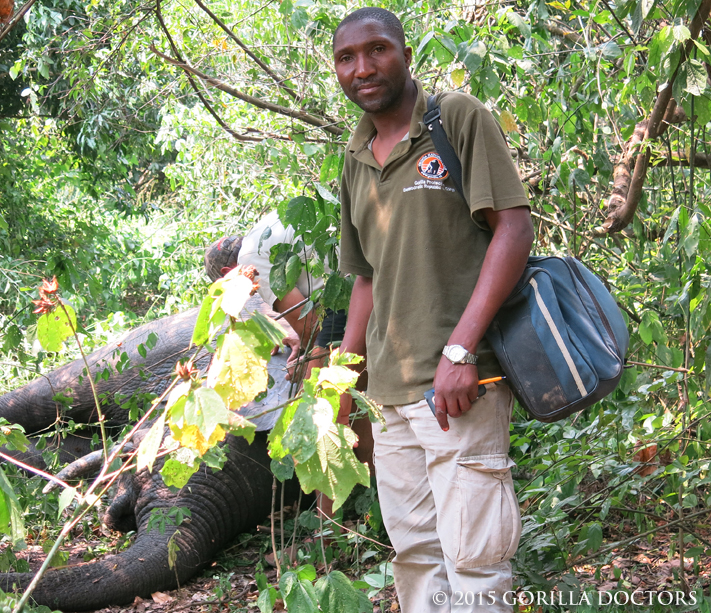Helping Virunga National Park Protect Wild Elephants
By Gorilla Doctors Staff on Wednesday, July 29th, 2015 in Blog.Poachers are targeting elephants in Virunga National Park to fuel the illegal ivory trade and Chief Park Warden Emmanuel de Merode and his incredible team of rangers are fighting back to protect these gentle giants. They have enlisted the help of Save the Elephants (STE), a Nairobi-headquartered nonprofit founded by renowned elephant researcher Dr. Iain Douglas-Hamilton. Dr. Douglas-Hamilton conducted the first behavioral studies of wild African elephants and through his work with STE, pioneered GMS collaring and tracking of elephants for their protection.
Last week, Gorilla Doctors Director, Dr. Mike Cranfield, as well as our Head DRC Vet Dr. Eddy Kambale assisted Virunga National Park staff, Dr. Douglas-Hamilton, Frank Pope, and Jerenimo Lepirei of Save the Elephants, and elephant veterinary expert Pete Morkel in fitting 15 elephants with tracking collars so that they can be closely monitored and protected from poachers.
According to STE, the high-tech collars “not only tell us how fast elephants move through certain areas, often proportional to the perceived level of threat, [they] can also give us exact positions of where families and vulnerable bulls are, allowing concentration of effort” within the national park. This information helps researchers and park staff to understand where the “hot spots” and “safe zones” are. The collars transmit information via satellite to the Park headquarters in Rumangabo in real-time, helping boost protection efforts in the exact location of the elephant herds. “If a collar stops moving – or travels unusually fast or slow – alerts are sent to security teams allowing for a rapid response” adds Frank Pope, Chief Operating Officer for Save The Elephants.
“Protection goes far beyond the life of one elephant” says Virunga National Park staff. “It impacts the physical and emotional wellbeing of the entire herd. Recent studies have shown elephants to be vulnerable to Post Traumatic Stress Disorder (PTSD). Like humans in highly stressful situations, elephants act out and become aggressive. This aggression makes an already tragic situation worse — it affects the herd, the rangers, and the local communities.”
Fitting a wild elephant with an electronic collar is no easy feat. Elephant veterinary expert Pete Morkel was tasked with darting each individual with anesthesia from a helicopter that hovered ten meters above the animal. The helicopter, expertly piloted by Africa Parks’ Frank Meltona, flew in once the Virunga team located the herd in a small ICCN airplane, so as not to scare the elephants.
Once darted, the elephant would continue moving until the anesthesia kicked in, so the team of veterinarians tracked the animal’s movements on the helicopter before landing. One of the challenges for the vet team was estimating the anesthesia dosage according to the body weight, condition and stress level of each elephant. “I was really excited to learn how to work with these big animals – it is very different from gorillas” said Dr. Eddy. “I learned when and where to dart with anesthesia, how to approach the animal, and how to monitor breathing and heart rate while under anesthesia.”
When the elephant was completely sedated, the team moved in quickly to fit the tracking collar. Drs. Mike and Eddy measured the tusks and collected blood, tissue, hair samples (from the tail) and swabs from each animal to conduct a baseline health assessment and disease surveillance. A small skin sample was collected from each elephant’s ear for genetic studies. Once everyone had completed their task, the team retreated to the helicopter while one vet remained behind to administer the anesthesia reversal – which would have the elephant back on it’s feet in a matter of minutes.
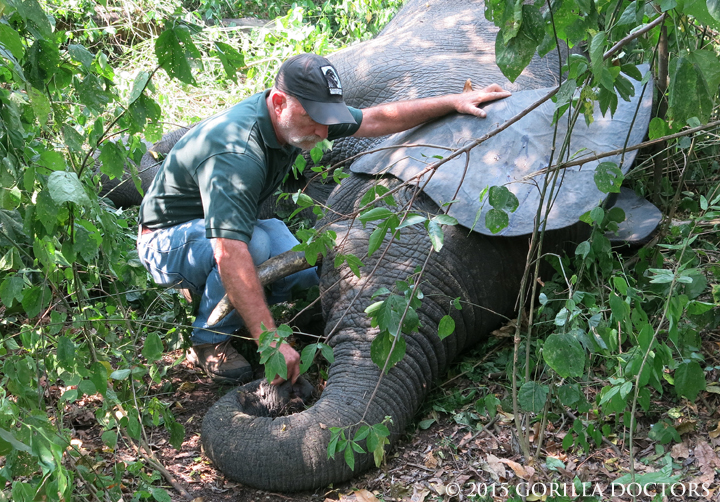
Dr. Mike Cranfield takes measurements and collects samples while the elephant is sedated for the collar fitting.
Collaring 15 elephants took the better part of a week, but Dr. Eddy said that most of the procedures went smoothly. Only once was the team charged by a bull elephant, while they were working in Mabenga Forest. On this occasion, an elephant in the herd was darted from the ground on the main road that runs from Goma to Kisangani. Once darted, the elephant immediately ran into the forest, joining the rest of the herd in dense vegetation. “It was quite scary to work inside the forest” said Dr. Eddy. “When the bull elephant charged, the field team made a lot of noise, but it didn’t deter the elephant. A ranger had to fire off a round into the air to stop the elephant in his tracks.”
With the death rate of elephants across most of Africa exceeding the birth rates, this impressive monitoring effort is critical to the species’ survival. We are very proud to support our partners in this project to protect these gentle giants!


 Donate
Donate
